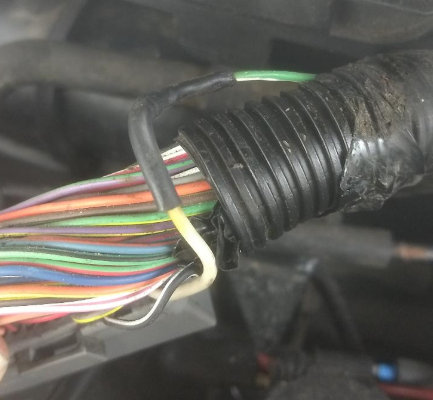I had a bit of an incredible car repair experience recently. It’s a bit of a long story, but the short version is that my 2001 Ford Escape was experiencing no spark on cylinder #1 and the problem turned out to be a bad splice in the wiring harness. The splice looked like it had been done in the factory, but the stranded wires were simply twisted together, and they had corroded over time. I’m pretty amazed that I actually found it.
This all started quite some time ago when I purchased a 2001 Ford Escape that was barely running. The main problem turned out to be several vacuum leaks, including the lower intake manifold gasket, which is a common problem with older Ford Escapes. However, even after fixing 3 different vacuum leaks, the car just wasn’t running quite right. There was an uneven idle, with a ‘huffing,’ as I described it. The engine made a rapid ‘huff-huff-huff’ sound as it was idling. It also ran the same way while driving, whenever the revs were low.
I eventually decided to check that every cylinder was working properly, by pulling each spark plug wire off and putting it back on with the engine running. This led me to discover that cylinder #1 was not doing anything. Luckily I had a spare coil and spark plug on hand, so I hooked them up and observed that there was no spark with the engine running. Clearly, I had an electrical problem.
I happen to own an oscilloscope, so I used it to compare the waveform for the bad cylinder with one of the good ones. What I found was quite perplexing. The waveforms were exactly the same. How could this be? The coils do draw quite a bit of current, so I took this to mean that the engine computer was operating normally, but there was some kind of connection issue along the way. Could it be a bad connector?
There were two wires to check, a white/purple that supplies a constant +12 volts, and a green/white that pulls the coil to ground for each spark. I used a light bulb to check that the +12 was working fine. This meant my problem was the green/white signal wire.
There were only two connectors to check, a midpoint wiring harness connector, and the huge connector to the engine computer (PCM). I disconnected the battery (both terminals!) and PCM, to avoid any potential damage and supplied +12 volts to the green/white wire at the spark plug connector, by shoving a small wire into the connector. Using a 12 volt light bulb connected to ground on the battery as a load, I used a safety pin to check for voltage on the far side of the midpoint connector. The light glowed brightly. So far so good.
At the PCM connector I ran into a problem. I couldn’t find the green/white wire. There’s a lot of wires, and you can’t clearly see them all, so I decided to probe every socket on the connector with my pin. None of them would light the light bulb. I went through every hole on the connector three times, but every single pin was dead. So what was up with that? Did the green/white wire go somewhere else?
Something I had noticed right away was that there was a strange wire splice near the connector, so I decided to have a closer look. I removed some black tape, pulled the wire out of the harness and, lo and behold, I found it was a different color at the connector, but it was connected to my green/white wire! Yes! Success! This had to be the problem. The tape was old, and there was heat shrink tubing over the splice, so it looked to me like this splice had been applied during manufacturing. Probably the socket for that pin on the connector was bad so they had to replace it.

I removed the heat shrink tubing and found the wires were simply twisted together and there was some green corrosion visible on the copper strands. I cleaned it up and applied some solder. After everything was put back together my engine finally ran smooth and even.
Anyway, I’m still amazed at this little find. It’s just not the kind of problem you’re expecting to find. I’m a little puzzled at the corrosion in the connection under the heat shrink tubing. Could this have been caused by electrical current? In any case, it would seem that simply twisting stranded wires together and applying heat shrink tubing is a bad practice. I always apply solder when doing this type of repair. It seems Ford might want to consider doing the same.
